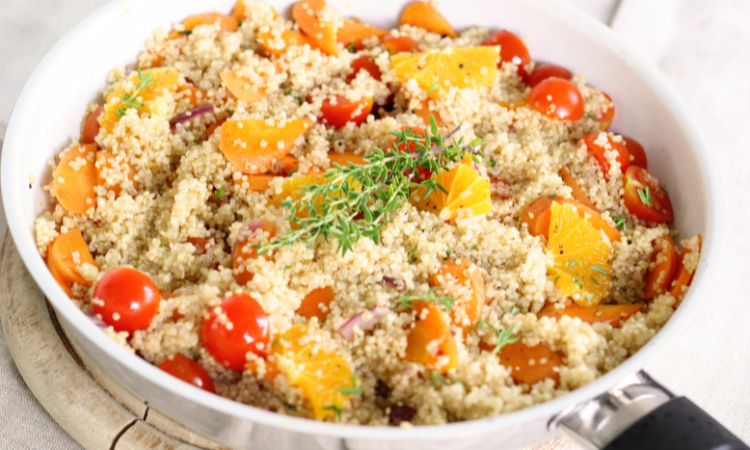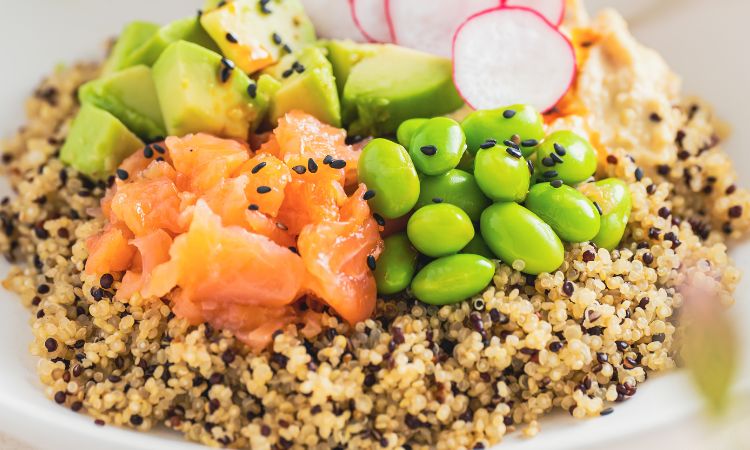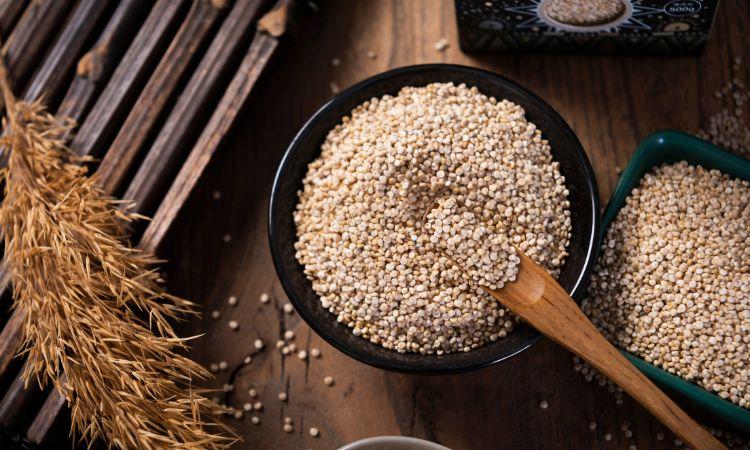Is Quinoa Gluten-Free? ( A Tasty, Healthy Treat for Your Tummy.)
Yes, quinoa is totally gluten-free. It’s not even a real grain; it’s a super cool seed that naturally doesn’t have any gluten. So, if you don’t like to eat grains like wheat, barley, or rye, quinoa is a yummy and nutritious option for you.
Plus, it’s like a blended seed because it’s filled with vitamins, minerals, amino acids and protein. And guess what? It’s full of antioxidants too. So, when you eat quinoa, you’re giving your body lots of good stuff.
To know more details about whether is quinoa gluten-free, let’s deep into the article-
What Exactly Is Gluten, and What Role Does It Play in Our Food?
First things first, what’s gluten? Gluten is a tiny protein complex made up of two components (gliadin and glutenin). These two proteins bind together to form and make bread light and fluffy.
Generally, grain crops hold these elements in their composition. Gluten is usually found in some commonly named grain crops like-
- Wheat
- Barley
- Rye
- Triticale
- Farina
- Spelt
- Kamut
- Wheat berries
However, gluten is like a special glue in food that keeps things stuck together, so food doesn’t fall apart.
But the good news is that lots of grains don’t have gluten naturally.
As an example, you can take buckwheat, It is a whole grain, and it doesn’t have any gluten in it.
So, you can eat buckwheat without worrying about gluten messing things up.
You should keep in mind that, some people can not tolerate gluten-containing food, so they have to be more careful about what they eat.
If you are sensitive to celiac disease (which is a gluten-sensitive disease ), you should keep away from gluten-containing foods.
N.B: “Gluten is natural but can be extracted, concentrated, and added to various products.”
What Exactly is Quinoa, And Why is It so Special?
Quinoa is a cool little seed that people often treat like a grain. It is produced from a herbaceous plant that is classified as a pseudocereal which means that it is not technically a grain but is used and prepared like one.
From a nutritionist perspective, quinoa is a complete protein, because it contains all nine essential amino acids that the human body cannot naturally produce on its own.
Besides, It is also a good source of fiber, iron, magnesium, and phosphorus.
Though quinoa is mainly of three types (black, red, and white), they serve the same nutritional properties in each of them.
You can choose this grain by taste, flavor, and availability. Here is an overview-
| Quinoa Color | Flavor | Texture | Usage |
|---|---|---|---|
| White | Mild | Fluffy | Versatile, Suites Most |
| Red | Slightly Nutty | Chewy | Salads, side dishes |
| Black | Intense | Crunchy | Textural contrast, salads |
How Nutritious The Quinoa Is?
Quinoa is a pretty awesome food with all essential amino acids that our bodies need. These amino acids help our bodies grow and stay strong, and quinoa has them all, which is super rare in the plant world.
Besides, it provides multiple minerals and nutrient components to our body directly.
Oh, and another important thing is that quinoa won’t make your blood sugar level go crazy like white rice can.
It has a lower glycemic index, which means it’s a better choice if you want to keep your energy steady.
Here’s the breakdown of what’s in one cup of cooked quinoa:
- 21% carbohydrates
- 14.6% protein
- 14.2% fat
- 222 calories
Fiber and sugar can also be obtained from quinoa grains.
Overall these properties minimize cholesterol levels and reduce the risk of heart disease.

Quinoa mix with orange, cherry tomato, and mixed vegetables.
Quinoa’s Gluten Content
Quinoa is a special grain that doesn’t have gluten naturally, which is really good for people who can’t eat gluten because of things like celiac disease or gluten intolerance.
But there’s a little problem sometimes.
When quinoa is grown, processed, or put in packages, it can sometimes meet up with gluten grains like wheat or barley by accident.
This makes it not safe for people who need to stay away from gluten.
So, you should be aware of and always look for quinoa that says ‘gluten-free’ on the package.
And when you read the names of the ingredients, make sure no wheat or barley is hiding in there.
If you’re not sure, ask your diet expert before having quinoa.
How Can Quinoa Be a Helpful Addition to a Gluten-Free Diet?
If you can add quinoa to a gluten-free diet, then it can be like the addition of a worry-free mealtime team. But why? Well, let’s look into it-
Super Safe:
Quinoa is totally a gluten-free grain. It doesn’t have any gluten in it naturally, so it’s a great option for people who need to stay away from gluten, like those with celiac disease which is termed gluten sensitivity.
As per the expert’s research, 10mg of gluten is considered a safe amount for celiac disease.
But in general, The average Western diet contains 10–20 grams of gluten per day which is a decent
Packed with Protein:
Quinoa has all nine special amino acids that our bodies need.
These amino acids help us grow, stay strong, and repair our bodies.
Not many plants can say that.
So, if you’re not used to eating meat or vegetarian, quinoa can fulfill the nutrition and provide you with the protein you need.
Versatility Galore:
Quinoa is a versatile grain that can easily be used in a variety of dishes along with local types.
Quinoa can also be added to salads, soups, or mixed with vegetables.
Here are some unique recipes that suit you well-
- Quinoa Stuffed Peppers
- Quinoa and Black Bean Burrito
- Casserole
- Quinoa Sushi
- Dessert
Read Also: The 5 Best Gluten-Free Snacks For Kids
Blood Sugar Buddy:
Quinoa has a lower glycemic index compared to white rice. This means it will give you energy for a long time and slowly, instead, it provides a steady stream of energy
So, in my perspective it’s a good food to keep you feeling full and energetic.
So, to sum it up, quinoa is like the perfect teammate for a gluten-free diet. It’s safe, super nutritious, and can be part of all kinds of tasty meals.

Recipes with quinoa avocado, olives with fresh fruits integration.
FAQ:
Is quinoa gluten anti-inflammatory?
Yes, It comes with anti-inflammatory properties.
Besides, this amazing pseudo-cereal is not only a complete protein and anti-inflammatory properties, also provides all nine essential amino acids.
Furthermore, It’s also brimming with fiber.
The quinoa is even more impressive beacause of the antioxidants it contains, such as quercetin and kaempferol.
These antioxidants have the potential and positive effects on inflammation in the body, which is necessary if sombody needs it.
Quinoa is also a digestive helper, potentially helping to ward off chronic diseases.
It might lend a hand in controlling cholesterol levels, and blood pressure, and even assist with weight loss.
And let’s not forget the minerals – quinoa is loaded with zinc, folate, iron, and magnesium. These minerals are like tiny superheroes that help keep our bodies healthy and strong.
You May Like: How Long Will Walmart Hold Grocery Pickup?
Which is better quinoa or oats?
If you compare two grains, here is an in-brief result with their relation and properties it has. By calculating the factors, you can choose as per your requirements-
| Factors | Quinoa | Oats |
|---|---|---|
| Protein Content | Complete protein with all essential amino acids | Good source of protein |
| Nutrient Density | Rich in vitamins and minerals, including iron, magnesium, and folate | Contains essential minerals |
| Gluten Content | Naturally gluten-free | Contains gluten, but gluten-free oats are available |
| Fiber Content | High fiber content aids digestion and promotes fullness | High in soluble fiber, beneficial for heart health |
| Versatility | Versatile; suitable for various dishes including salads, grain bowls, and more | Versatile; commonly used in oatmeal, granola, and baked goods |
| Heart Health Benefits | Lower glycemic index; potential blood pressure and cholesterol control | Contains beta-glucans for cholesterol reduction |
| Cost | Generally more expensive than oats | Often more budget-friendly |
So, which one is better?
It really depends on your personal dietary goals and habits.
If you’re really looking for a complete protein source or need a gluten-free option, quinoa is an excellent choice.
On the other hand, if you’re focused on heart health and want a cost-effective option, oats are a great pick.
You can also include both in your diet to enjoy their unique benefits.
Conclusion
So, there you have it. Quinoa is indeed gluten-free, but you have to watch out for sneaky gluten friends. Always look for the “gluten-free” label to make sure you’re getting the safe kind.
And if you can eat quinoa, you’re in for a treat because it’s not only safe but also super delicious and healthy.
Remember, eating gluten-free can be a challenge for some people, but with tasty options like quinoa, it’s not so bad after all.
Whether you are searching for the answer to the question “Is quinoa gluten-free?”, which I hope you now know the answer to, or are simply looking for a delicious and nutritious food, quinoa is here to save the day!
As an experienced WordPress blogger, I possess extensive expertise in constructing captivating blog websites. My proficiency extends to various areas, including content writing, meticulous niche and keyword research, and the implementation of on-page SEO techniques to maximize visibility and engagement.



